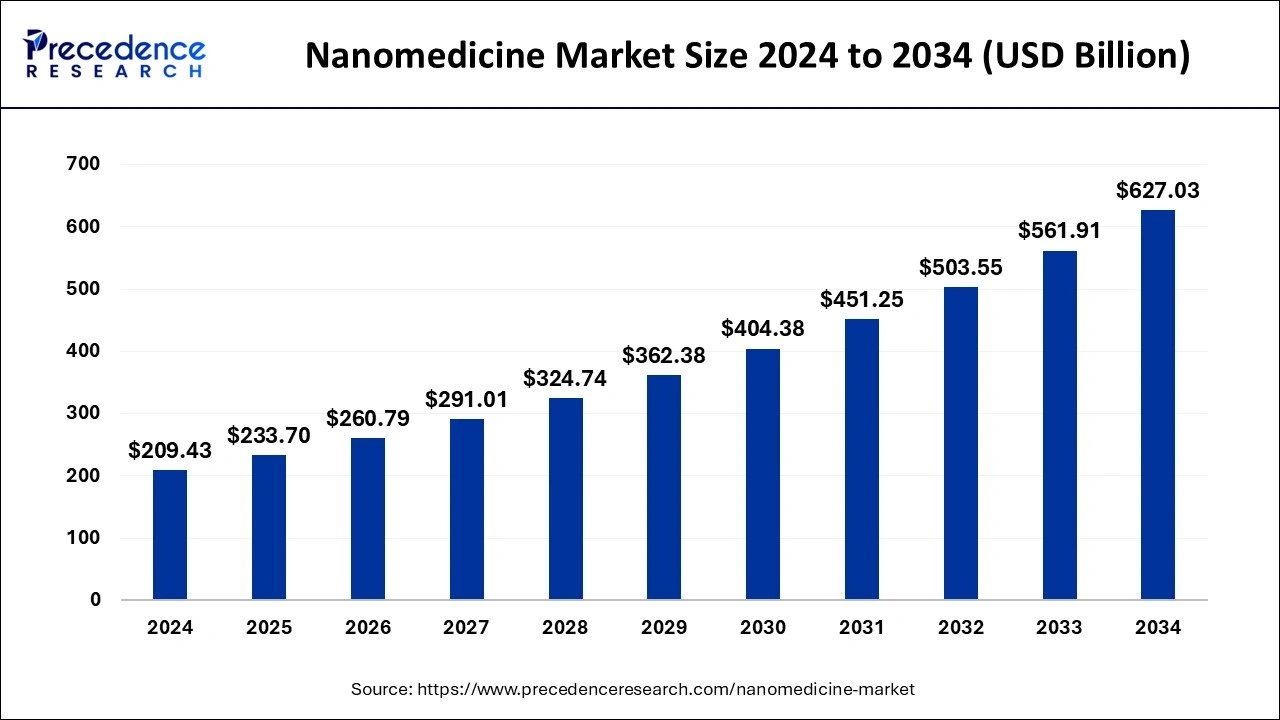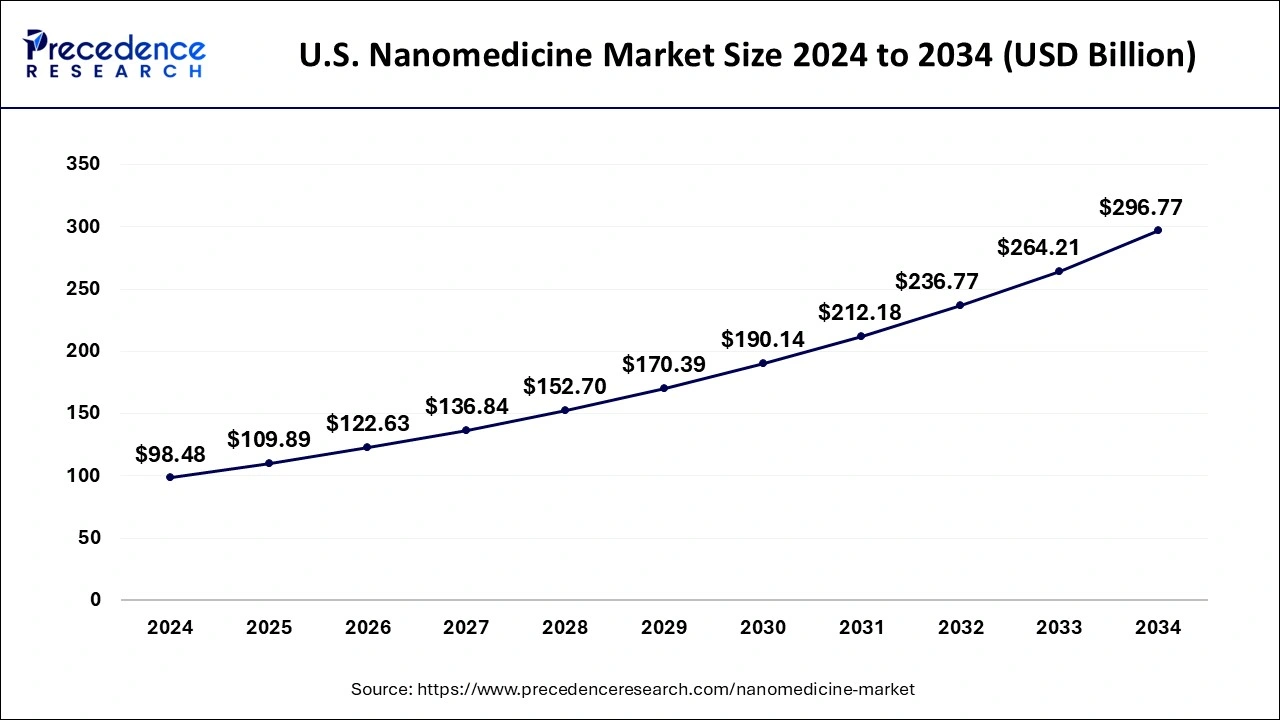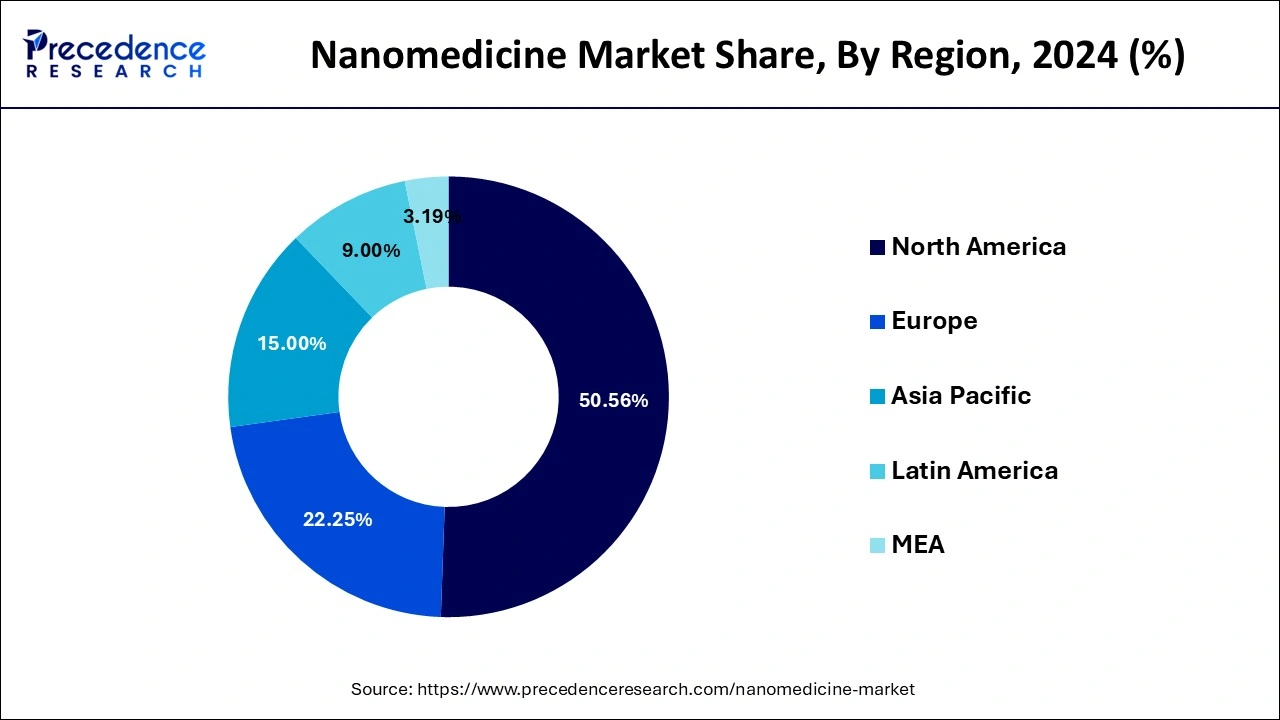The global nanomedicine market size was accounted for USD 209.43 billion in 2024, grew to USD 233.70 billion in 2025 and is predicted to surpass around USD 627.03 billion by 2034, representing a healthy CAGR of 11.59% between 2025 and 2034. The North America nanomedicine market size was calculated at USD 105.89 billion in 2024 and is expected to grow at a fastest CAGR of 11.60% during the forecast year.
The global nanomedicine market size was estimated at USD 209.43 billion in 2024 and is anticipated to reach around USD 627.03 billion by 2034, expanding at a CAGR of 11.59% from 2025 to 2034.

Nanomedicine design also benefits from the use of AI to improve the quality of the product as it predicts interactions with drugs, biological fluids, the immune system, the vascular system, and cell membranes, all of which affect health. The high level of heterogeneity in tumors and between patients makes rational design of diagnostic and therapeutic platforms and analysis of their outcomes quite challenging. Integration of AI can fill this gap by using analytical models and classification algorithms to improve the accuracy of diagnosis and treatment. AI algorithms used to classify patients, screen patients for appropriate drug use, and optimize nanomedicine products have proven their value in precision medicine. AI is also used in engineered nanomedicine to optimize properties based on interactions with drug targets, biological fluids, immune systems, and cell membranes, leading to the growth of the nanomedicine market.
The U.S. nanomedicine market size was evaluated at USD 98.48 billion in 2024 and is predicted to be worth around USD 296.77 billion by 2034, rising at a CAGR of 11.66% from 2025 to 2034.

North America led the global nanomedicine market with the largest market share of 50.56% in 2024. The technological advancements combined with relevant applications in early disease diagnosis, prevention, and prophylactic of acute and chronic disorders are expected to drive the nanomedicine market growth in the U.S.
Asia-Pacific, on the other hand, is expected to develop at the fastest rate during the forecast period. Various research and development efforts are also now occurring in the region on pharmaceuticals and diagnostics based on nanotechnology, which may fuel the nanomedicine market expansion.
The government-led nanotechnology initiative is coordinated by the Department of Science and Technology (DST)’s Nanoscience and Technology Mission (NanoMission) for Asia-Pacific.

The use of nanotechnology-based contrast reagents for diagnosis and monitoring of pharmacological effects on an unprecedentedly short timescale is also expected to fuel future growth. The demand is also expected to be influenced by the demand for biodegradable implants with extended lifespans that allow for tissue repair. Nano formulations with triggered release for tailored pharmacokinetics, nano-substances for the tumor management coupled with the radiation and nanoparticles that functions for targeted in-vivo stimulation of the cell production are expected to drive research and development in the future years.
The rising out licensing of nano medicines and the expansion of healthcare facilities in emerging markets are helping to create a market growth potential. The technological improvements such as applications in early illness diagnosis, prevention of acute and chronic ailments, and preventive intervention are likely to drive the nanomedicine market expansion. The nanotechnology entails a number of steps. The nanotechnology is the miniaturization of bigger structures and molecules on a nanometric scale, which has influenced the technology’s adoption.
The worldwide nanomedicine market is likely to be driven by the increasing applications of nanomedicine as a result of technological developments in nanotechnology. There has been a boom in research activity in the field of nanotechnology, both by governments and private institutions as well as in the experimental use of this technology to cure a number of chronic diseases. This, together with the nanomedicine market’s high unsatisfied medical needs, large geriatric population, and rising incidence of chronic and acute disorders is expected to give it a major boost to the nanomedicine market.
The increased global burden of chronic and infectious disorders is driving the global nanomedicine market. Cancer is the second largest cause of death worldwide, according to the World Health Organization, responsible for more than 9.5 million deaths in 2018. The nanomedicine’s ability to control lymphoid and myeloid cell activity as well as improve anticancer immunity and immunotherapy efficacy will boost its use in cancer treatment. Furthermore, the opening of a NanoTherm treatment facility is likely to help the business to flourish.
Thus, the rising prevalence of genetic and cardiovascular illnesses, increasing breakthroughs in nanoscale technologies for diagnostic processes and a growing preference for tailored treatments are all driving the growth of the healthcare nanotechnology industry. On the other hand, the nanomedicine market’s expansion is hampered by severe regulatory issues and the high cost of nanoparticle assisted medicine in comparison to its traditional counterparts.
| Report Coverage | Details |
| Market Size in 2024 | USD 209.43 Billion |
| Market Size in 2025 | USD 233.70 Billion |
| Market Size by 2034 | USD 627.03 Billion |
| Growth Rate from 2025 to 2034 | CAGR of 11.59% |
| Largest Market | North America |
| Base Year | 2024 |
| Forecast Period | 2025 to 2034 |
| Segments Covered | By Modality, By Application, By Indication, By Nanomolecule Type |
| Regions Covered | North America, Europe, Asia-Pacific, Latin America, and Middle East & Africa |
Advancements in Nanomedicine and Nanoparticle Development
Nanomedicine is experiencing significant growth due to its advantages over bulk and molecular medicines, such as precision, biocompatibility, and the ability to address unmet medical needs. The development of new nanoparticles with unique nanostructured surfaces has proven to be effective in drug development. The nanoscale size of nanomaterials increases the surface area-to-volume ratio, increasing the surface energy and reactivity of the materials. This improved performance also increases economic growth as it provides new solutions to complex medical problems by creating the therapeutic effect of nanomedicine.
Advancements in Nanomedicine and Drug Delivery Systems
Recent developments in the preparation of colloidal drugs have created significant opportunities in the nanomedicine market, especially in the development of safe and effective drug carriers. Innovations in liposomes, nanoparticles, polymer nanoparticles, micelles, gold nanoparticles, and other colloidal carriers have improved drug delivery to Nanoparticles (NPs), which have gained popularity in the last decade due to their therapeutic effects. The ability to produce large nanoparticles with size and distribution provides a continuous and reproducible production process as well as market growth. In addition, the ability to store nanoparticles in the production plan and physical environment also benefits the expansion of the nanomedicine market along with the rapid progress in nanoscience, technology, and cancer.
Challenges in Nanomedicine Development and Accessibility
The growth of the nanomedicine industry is limited by several challenges, including the long-term toxicity of nanomedicines, which can cause serious complications in clinical trials. Even if the nanoparticles are produced using FDA-approved materials, repeated oral administration of nanomedicines can also affect the gastrointestinal tract. Furthermore, developing safe and effective nanomedicines requires a multifaceted approach involving collaboration between scientists, engineers, physicians, and regulatory agencies, which can hinder the development process. Furthermore, the high production costs of nanomedicines make them inaccessible to many patients, limiting their widespread use and disrupting the nanomedicine market.
The regenerative medicine segment has held the largest market share in 2024. The regenerative medicine is a new field of medicine that aims to restore of restore normal function by replacing, engineering, or regenerating human cells, tissues, and organs that have been lost or harmed due to age, diseases, or congenital abnormalities.
The diagnostic imaging segment, on the other hand, is predicted to develop at the quickest rate in the future years. The diagnostic imaging refers to a variety of procedures for looking into the body to determine the source of an illness and damage and confirm a diagnosis. Doctors also use it to assess how well a patient’s body responds to fracture or diseases therapy.
The cardiovascular diseases segment captured the biggest revenue share in 2024. The heart or blood vessels are affected by this sort of sickness. High blood pressure, smoking, high cholesterol, a poor diet, and obesity can all raise the risk of cardiovascular disease.
The oncological diseases segment, on the other hand, is predicted to develop at the quickest rate in the future years. The main oncological disease is cancer. The different types of cancers such as breast cancer, stomach cancer, and lung cancer are categorized into oncological diseases.
By Modality
By Application
By Indication
By Nanomolecule Type
By Geography
For inquiries regarding discounts, bulk purchases, or customization requests, please contact us at sales@precedenceresearch.com
No cookie-cutter, only authentic analysis – take the 1st step to become a Precedence Research client